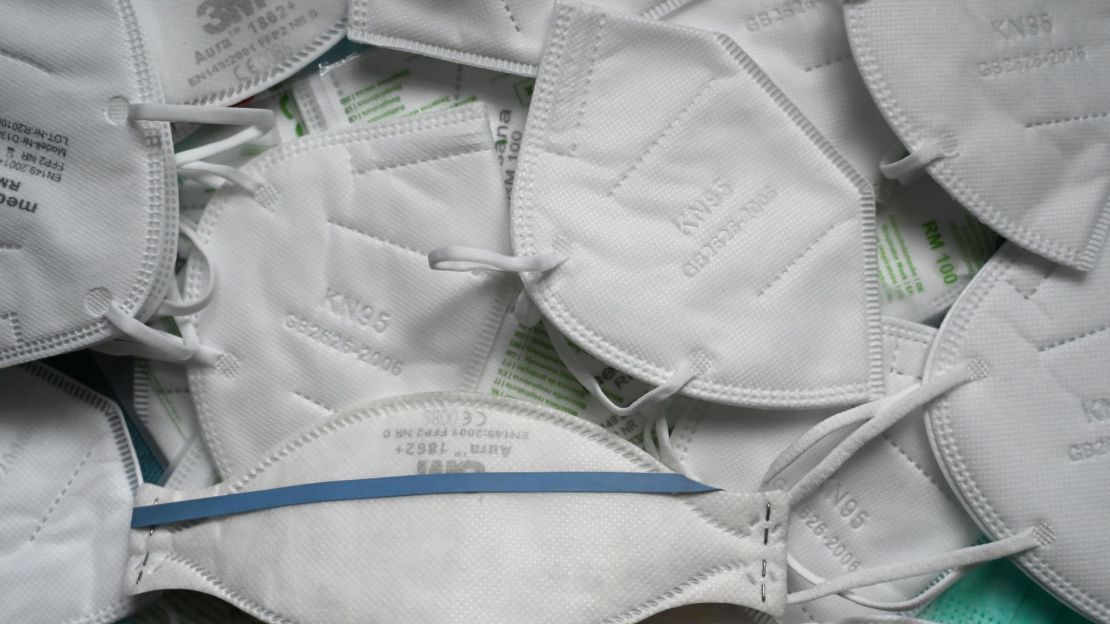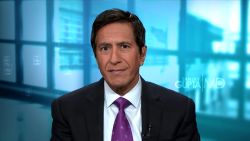This is the weekly edition of CNN’s coronavirus newsletter. Look out for your roundup every Wednesday. If you haven’t subscribed yet, sign up here.
If you’re still wearing a cloth or surgical mask when you’re out and about, it’s time to rethink your face covering.
The US Centers for Disease Control and Prevention (CDC) is set to update its mask advice this week to best reflect the available options and the different levels of protection they provide, a CDC official told CNN Tuesday.
Many experts say cloth and surgical masks don’t provide enough protection, and instead encourage N95 or FFP2 coverings.
Upgraded masks are already the norm in much of Europe. Germany mandates FFP2 coverings in stores, on public transport and in other public places. Neighboring Austria made FFP2 masks mandatory outdoors on Tuesday, when it is not possible to keep a minimum two meters from people outside one’s household, and they have been required indoors since last month.
Italy mandated the heavy-duty masks to enter stadiums, museums, cinemas and theaters, and use public transport from December. And in Greece, anyone who has left self-isolation must wear them in any public place for five days.
The differing terminology for the masks can be confusing, but all the terms refer to the level of filtration offered by the covering – and there’s no doubting that FFP2, N95 or KN95 models offer better protection than those made from cloth or other fabrics.
Cloth masks – encouraged earlier in the pandemic – can stop large droplets, while more effective masks can also filter smaller aerosols or particles potentially laden with airborne virus.
Properly fitted N95 respirators that are approved by the US National Institute for Occupational Safety & Health can filter up to 95% of particles in the air, according to the CDC.

A cloth face covering, by contrast, also has 75% inward and outward leakage, which the American Conference of Governmental Industrial Hygienists defines as the “percentage of particles entering the facepiece” and the “percentage of particles exhaled by a source exiting the facepiece,” respectively.
People concerned about the best way to protect themselves and their loved ones during this surge of Omicron variant cases should “get the highest-quality mask that you can tolerate and that’s available to you,” Dr. Anthony Fauci, director of the National Institute of Allergy and Infectious Diseases, told CNN’s Anderson Cooper on Tuesday, signaling a switch in the official advice.
The issue thus far is that filtration masks are generally more expensive, a bit less convenient to wear and earlier in the pandemic they weren’t always widely available.
That explains why the CDC has until now actively encouraged members of the public against buying N95 masks – currently stating on its website that they should be “prioritized for healthcare personnel.”
But Fauci told CNN that “right now, [there] doesn’t seem to be any shortage of the masks that some time ago were not available.”
“What the CDC has said – and it gets misinterpreted – they’re saying, wearing any mask is better than no mask at all,” Fauci said. “But there is a gradation of capability of preventing you from getting infected and from you transmitting it to someone else. So we should be wearing the best possible masks that we can get. That’s a fact.”
CNN’s Nina Avramova contributed reporting
YOU ASKED. WE ANSWERED.
Q: When is it safe to leave isolation if I’ve had Covid-19?
A: Guidance around isolation times is continuously changing across the world – and can at times be confusing and contradictory.
If you’ve tested positive, the first step is to check what the guidance is where you are. In the US, people can leave isolation after five days if their symptoms have resolved – no negative test is required – and they should then wear a mask around people for five more days.
In other countries, it can be as long as 14 days. But more regions are allowing early exits from isolation if patients are asymptomatic, which leaves it up to you to judge whether you should be doing so.
The chance that you’re still infectious drops as time goes on. The longer you stay isolated, the less likely you’ll expose someone else to the virus. Ten days after testing positive, the percentage of people still contagious is estimated to be about 5%, according to researchers at the UK Health Security Agency.
However, at day five, the end of the CDC isolation period, a significant percentage of people (31%) are still contagious. By day seven, the percentage of people still contagious drops by half – to about 16%.
If you have access to a rapid antigen test, it can be helpful to take one or two during your isolation. Combining a negative result with self-assessment of your symptoms should help you reach a conclusion as to whether you should leave isolation at the earliest stage allowed in your country.
Send your questions here. Are you a health care worker fighting Covid-19? Message us on WhatsApp about the challenges you’re facing: +1 347-322-0415.
READS OF THE WEEK
Covid cases in children are surging. Schools aren’t prepared
As Covid-19 cases skyrocketed across Britain in late December, Stuart Guest spent his vacation poring over scientific reports about air cleaning and filtration systems.
Guest, a head teacher at an elementary school in Birmingham, England, scoured Amazon for affordable air purifiers in the hopes of stopping the more transmissible Omicron variant from spreading among his 460 students, who are between 3 and 11 years old.
“I got what I think is the best air purifier for the budget I have available. I hope I’ve got something that’s doing the job, but I’m not an expert. And there’s been no guidance put out by the Department for Education. I’ve had to do it all myself, and I shouldn’t have to do that when it’s a national crisis,” Guest said.
Millions of British students have returned to school following the Christmas and New Year holidays, amid a record surge in infections and hospitalizations. For teachers and parents, the situation has brought a grim sense of déjà vu, writes Eliza Mackintosh.
And in the US, more children are being admitted to hospitals than ever before. The Biden administration has said schools are “more than equipped” to stay open, as Omicron rips across the country.
But some elected officials are erring on the side of caution by delaying the new term, while a teachers’ union forced public schools in Chicago, Illinois, to shutter for a week amid criticism from members that conditions in classrooms are dangerous.
Beijing on high alert as China’s first Omicron cluster edges closer before the Olympics
Officials in Beijing are on high alert just weeks out from the start of the Winter Olympics, after China’s first local outbreak of the Omicron variant spread from the northern port city of Tianjin to the central province of Henan.
Tianjin, located just 80 miles southeast of Beijing, reported at least 40 positive cases over the weekend, including 24 children, though health authorities have yet to confirm whether they are infected with Omicron.
But the virus has already spread far outside the city. State media reported Monday that two more Omicron cases had been identified in Anyang city, Henan province, more than 300 miles from Tianjin, Nectar Gan and Steve George report.
In recent months, Chinese authorities have imposed ever more stringent restrictions to curb local Covid flare-ups as Beijing prepares for the Olympics. An Omicron outbreak on the doorstep of the capital just weeks before the Games kick off on February 4 represents something of a nightmare scenario for officials – who are now likely to ramp up efforts to protect Beijing.
No, you shouldn’t deliberately catch Omicron to ‘get it over with’
The question hung in the air like a bad odor, silencing the small group of fully vaccinated and boosted friends and family at my dinner table.
“Why not just get Omicron and get it over with? It’s mild, right? And it can boost immunity?” The fully vaccinated, boosted, well-educated friend who asked was sincere, echoing opinions heard on many social platforms.
The idea of intentionally trying to catch Omicron is “all the rage,” said Dr. Paul Offit, the director of the Vaccine Education Center at Children’s Hospital of Philadelphia, with an exasperated sigh.
“It’s caught on like wildfire,” agreed Dr. Robert Murphy, executive director of the Havey Institute for Global Health at Northwestern University Feinberg School of Medicine.
“And it’s widespread, coming from all types of people, the vaccinated and boosted and the anti-vaxxers,” he added, with a warning. “You’d be crazy to try to get infected with this. It’s like playing with dynamite.”
TOP TIP
The US Food and Drug Administration is cautioning against adding self-collected throat swabs to nasal Covid-19 tests and says people should use the tests as instructed.
“FACT: When it comes to at-home rapid antigen #COVID19 tests, those swabs are for your nose and not your throat,” it said on Twitter.
Why the warning? After anecdotal reports of sore throats with coronavirus infection and early studies suggesting that saliva may be a better way to detect the Omicron variant, some people began taking antigen test swabs intended for nasal samples and using them to swab their throats.
The home test tweak took off after people began posting their results on social media with the hashtag #SwabYourThroat.
The FDA warned last week that throat swabs “are more complicated than nasal swabs – and if used incorrectly, can cause harm to the patient. The CDC recommends that throat swabs be collected by a trained healthcare provider.”
Throat swabs are common in some places, such as the United Kingdom, but in the United States, most self-tests require nasal specimens; a few involve saliva collected by spitting into a tube.




















